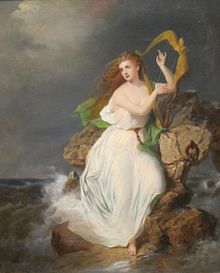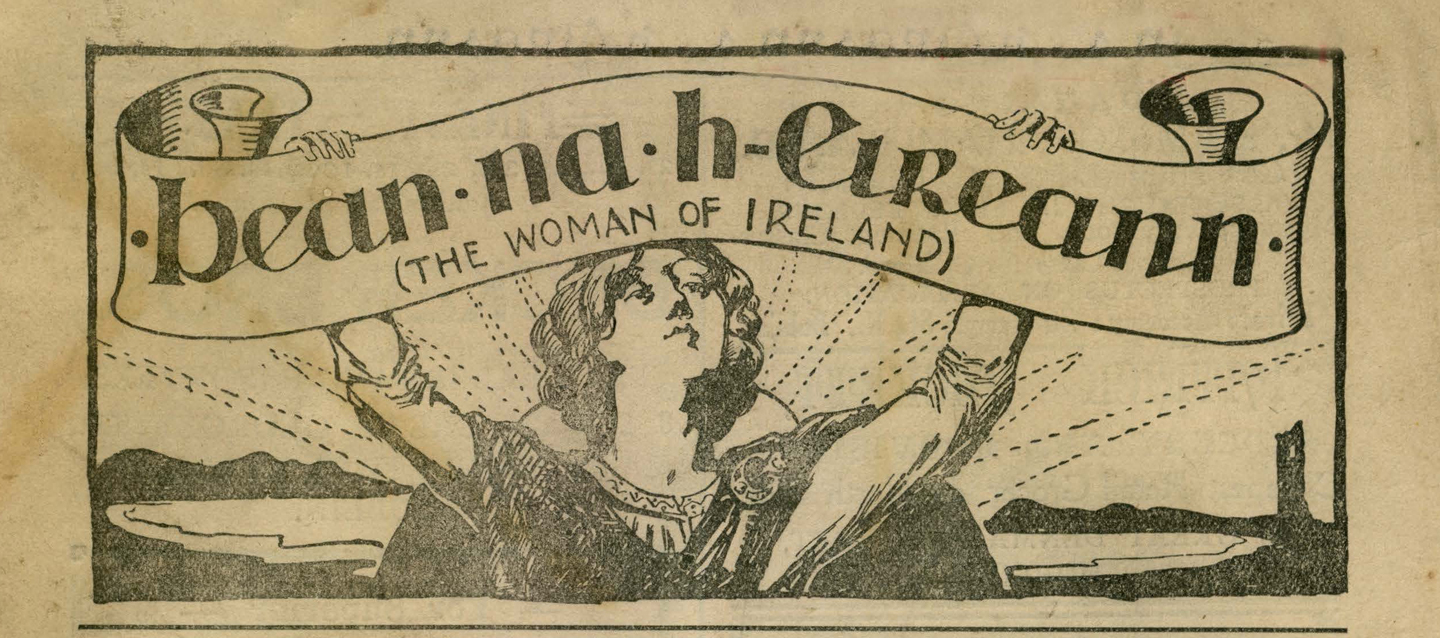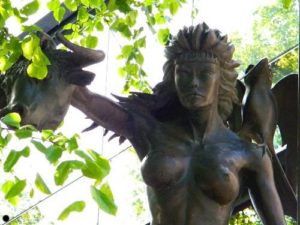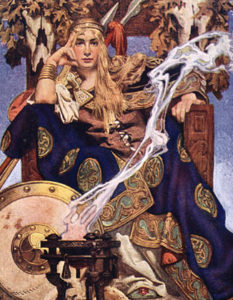
Eriu, or Erin, is first mentioned in “Lebor Gabála Érenn”, or “The Book of the Taking of Ireland” is a collection of poems detailing the history of Ireland. The earliest known copy of The Book of the Taking of Ireland was by an anonymous writer in the 11th century. Often celebrated as a sovereign goddess, Eriu represents Ireland in the form of a woman. Eriu was one of three sisters, the other two are likewise considered sovereign goddesses of Ireland, however, neither Banba nor Fódla are as well known or respected as Eriu.
One of Eriu’s better-known legends, and the reason Ireland is named after her, is outlined in Patricia Monaghan’s book, The Encyclopedia of Celtic Mythology and Folklore. The myth speaks of the invasion of the Melesians, and how Eriu and her sisters stood against the invaders and demanded they leave. “One, Donn mac Miled, replied to her demands with insults, and Eriu calmly sentenced him to death; he drowned shortly thereafter.” Thus Ireland was named after Eriu, later seen as Erin, and she became a popular symbol for Romantic Ireland in countless stories and poems.
In her time ruling Connacht, Maeve or Mebd was fiercely independent and did little to hide her desires. Maeve shows the power of her wealth and property in what she expected from her husbands. Maeve ensured that any man who married her understood that he was simply one in a series of husbands, and he must never display jealousy. Maeve had many lovers and five husbands who held the title of King while married to her.
In Ancient Ireland, whoever owned brought more wealth and or property into the marriage, man or woman, was the ruler of the household. If a woman was in possession of greater wealth than her husband, he was called fer fognama (“man of service” or “man without power over a wife”). While Maeve believed that she had brought more wealth to her marriage to Ailill mac Máta, Ailill stated his possession of a stud bull of great value. In fact, it was so valuable, that only one other bull in Ireland could rival it. Maeve, determined to assert her dominance over their marriage, called her contingents to arm.
The famous tale, Táin Bó Cúailnge (“The Cattle Raid of Cooley”) tells of Maeve’s confrontation of her enemy, Dáire mac Fiachna, in Ulster. Maeve eventually procures Fiachna’s prize stud bull and not only displays her prowess in battle but in her marriage as she equaled the wealth and power of her husband. Unwilling to live in the shadow of Connaught’s prodigious Queen, Ailill eventually left Connaught.
In addition to Táin Bó Cúailnge, Queen Maeve of Connacht plays a role in fourteen other tales and sagas. When Maeve is killed in an act of revenge, she is said to have been buried in Sligo, standing and facing her enemy in Ulster in a high stone cairn on the summit of Knocknarea (Cnoc na Rí in Irish, Hill of the King).
Modernity Co-opting Myth
The legacies of Erin and Maeve, like those in other classic folklore of the ancient Irish tradition, were co-opted in order to be used in modernity as a symbol of Ireland. While Maeve has previously been interpreted as a goddess displaying the intoxicating power of passion and the line between love, hate, sex and violence, she has recently been considered under a new light.
In her book, The Goddess-Turned-Heroine of the Celts: Queen Medb and the Sovereignty of Ireland by Miriam Robbins Dexter, Dexter explores Maeve is a paradox,
“She is a powerful woman who is both wealthy and a warrior.”
Dexter continues to state how Maeve’s power existed not only in the time she is believed to but for women centuries later. Maeve’s economic and sexual autonomy acted as blazing encouragement for the women of modern Ireland to live as fiercely and boldly as Maeve did.
Far from the fiercely independent and individualistic examples set by the Warrior Queens in the original lore, modern coinage of “Erin” was used to represent mother Ireland and give “her” the mythic but sublime allure that the Irish nation needed in order to be seen as real, or at least something worth believing in.
Erin was mentioned often in modern nationalist poems and songs. In “The West’s Asleep” by Thomas Davis, both a poem and a popular Irish folk tune, the image of Erin as Ireland is uttered in melancholy:
“When all beside a vigil keep,
The West’s asleep, the West’s asleep—
Alas! and well may Erin weep,
When Connaught lies in slumber deep.”
Here, Ireland is personified as an emotional Erin, whose weeping might hint at an attempt of hysterization of the woman. This emotive portrait of Ireland as a woman is just one example of many during the Modern period where artists and writers alike continuously relied on a misinterpreted trope of Erin to influence nationalist vigor and sentiment.



